Want to make chocolate chip cookies? This guide will go through the science of chocolate chip cookies, storing the raw dough or the baked cookies, and also how to adapt your favourite chocolate chip cookie recipe with the flours you want to bake with, whether that's a flour with gluten (whole wheat flour, rye, or spelt), or a gluten-free alternative (oat flour, corn flour, and even buckwheat).
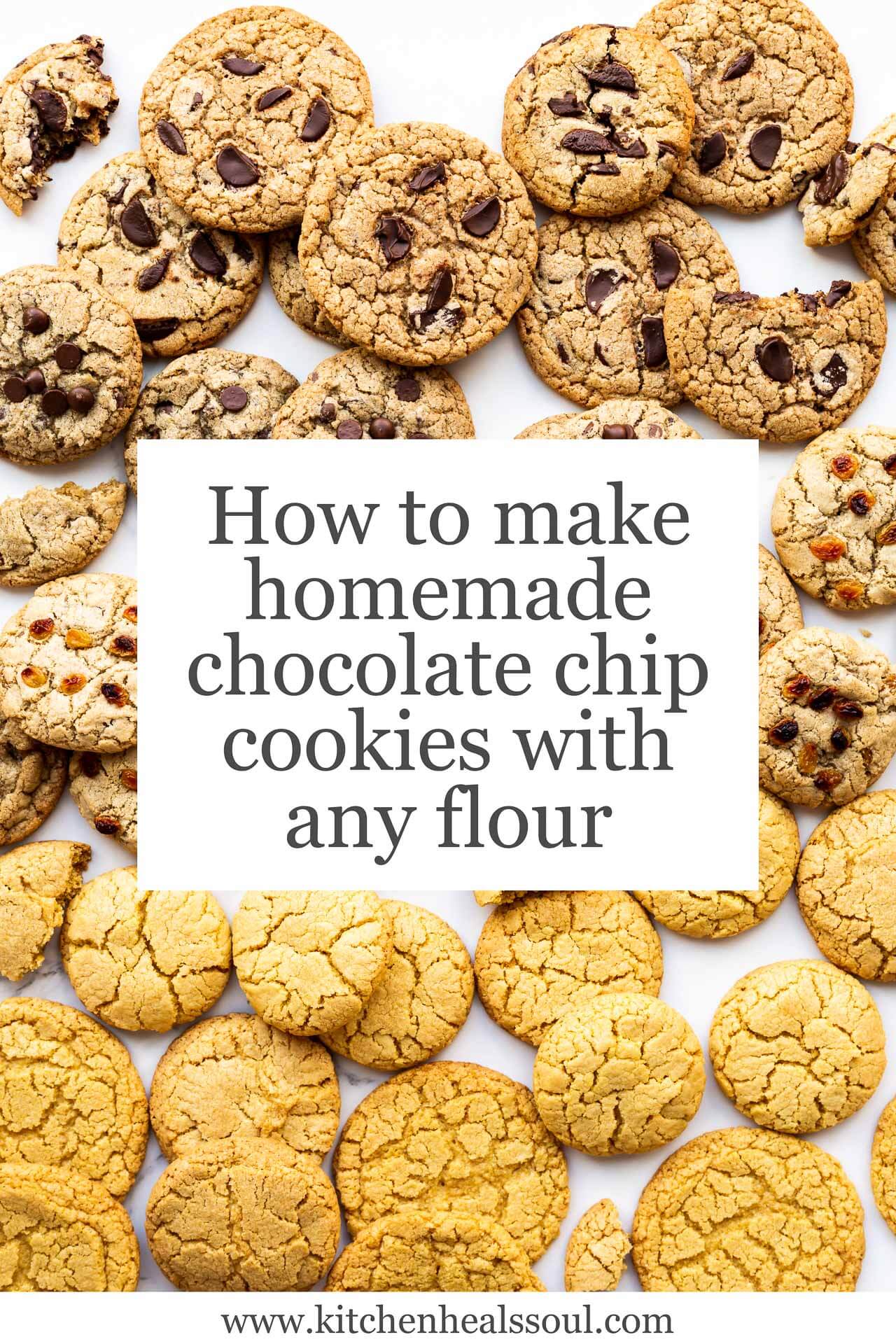
Everybody has a different description of the best chocolate chip cookie that is their absolute favourite. That's normal. My best chocolate chip cookie won't necessarily be your favourite, and vice versa. Describing any food as "best" is highly subjective and up for interpretation. It can depend on your age, your history and what you grew up eating, where you live, your friends....
Your favourite chocolate chip cookie will evolve with time. Some days, all you may want is raw cookie dough straight from the mixer bowl, or a super gooey, under-baked cookie that is soft and melty. Other days, you might crave a thin, crispy, dry, even sandy textured chocolate chip cookie. Lately, I've fallen in love with chewy chocolate chip cookies. But actually, when they are freshly baked, they have a crispy edge and raw middle. When you store them they mature, and they develop a chewier texture that I find highly addictive.
I'm not here to tell you that this is the best chocolate chip cookie, but I would like to discuss how to take your favourite recipe and adapt it to suit your needs, or your dietary restrictions, or a national shortage of all-purpose flour. How do you swap one flour for another? What do you do if you are stuck with a gluten-free flour to work with that isn't a pre-mixed blend to replace all-purpose, cup-for-cup. What if you want a cookie that spreads thinner as it bakes, or a cookie that is more gooey?
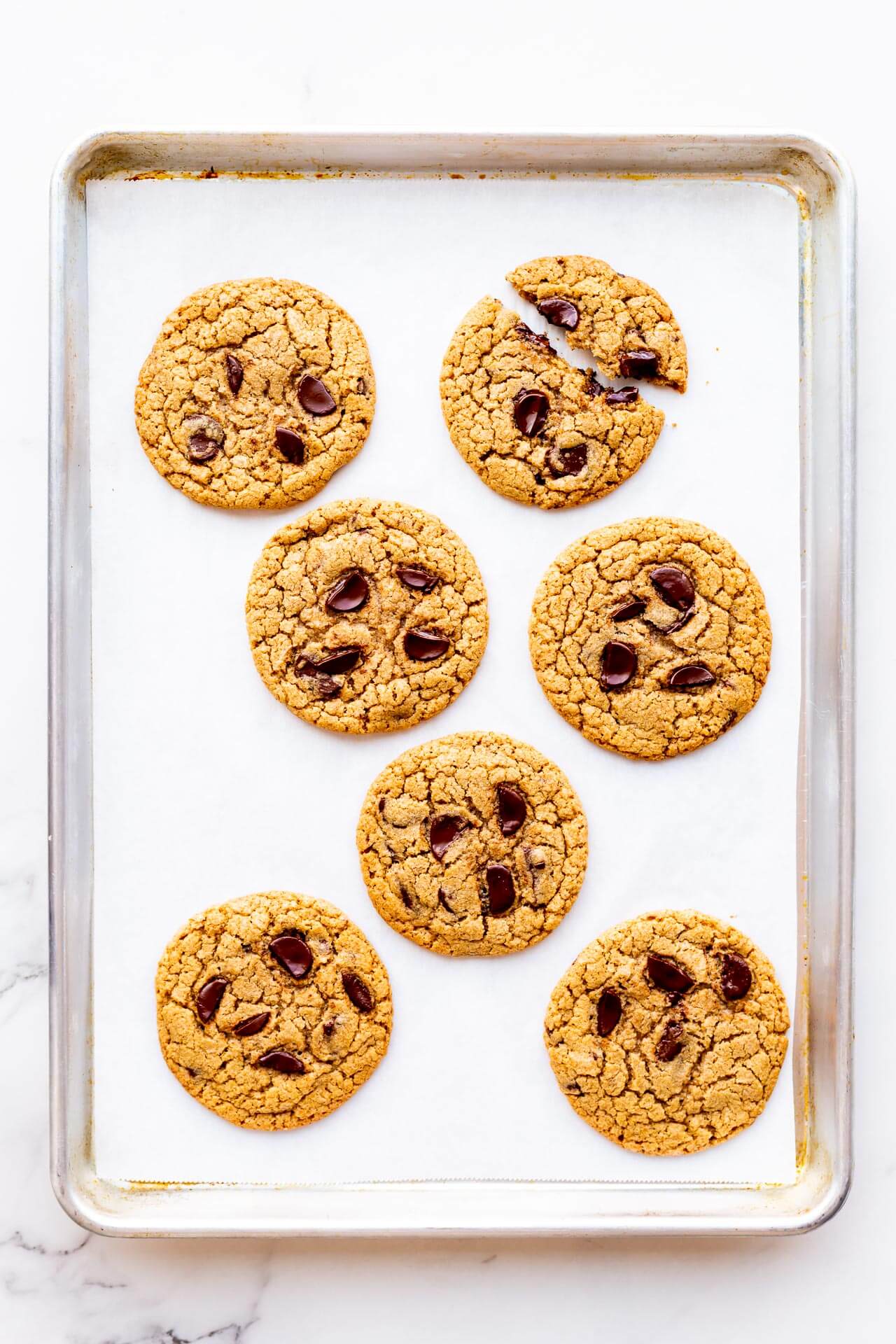
Jump to:
- Tools to bake the best chocolate chip cookies
- The basic ingredients to make chocolate chip cookies
- To chill or not to chill
- What's the best temperature to bake chocolate chip cookies at?
- How to store raw cookie dough
- How to store freshly-baked chocolate chip cookies
- How to change the type of flour used in a chocolate chip cookie recipe
- Other ways to change up this recipe:
- Troubleshooting
- 📖 Recipe
Tools to bake the best chocolate chip cookies
There are tools, equipment, and bakeware that I use when I make chocolate chip cookies. If you plan to make cookies often or bake more regularly, these are some of the essential baking tools you might want to consider investing in. These items make baking sessions easier and more successful!
- Kitchen scale: I cannot stress enough how much easier it is to measure out ingredients by weight. If you are interested in making the switch to a digital scale, I like this OXO Good Grips kitchen scale available on Amazon. I use it all the time and it takes standard AAA batteries which you probably have on hand most of the time. Make sure to do your mise-en-place, the French baking term for measuring out all your ingredients before proceeding to make the recipe.
- Electric hand mixer: most of us used to make cookies with a good old wooden spoon, but now I don't have the stamina, the arm strength, or the motivation, honestly. I have used an electric hand mixer from Braun (Multimix HM5100 available on Amazon) to make these cookies and it works well. I've also used the KitchenAid Artisan mixer. Both work!
- Large bowl with a rubber or silicone grip on the bottom: if you are going to make cookie dough with a hand mixer, invest in a GIANT 8 quart stainless bowl with a rubberized bottom so it is stable on the counter and this way, the bowl won't dance around as the mixer runs. This set from Amazon will do the trick. Or buy a stainless bowl without a rubberized grip and nest it in a damp towel to stabilize it while mixing.
- Cookie scoop: this style of cookie scoop comes in a variety of sizes. Some call it a "disher" and it's the most reliable scoop I've found (available on Amazon). They can handle firm doughs without breaking because the release mechanism is separate from the handle! This gives you a better, firm grip on the handle, without the risk of breaking the leaver.
- Baking sheets: invest in large baking sheets, also known as half sheet pans, with the following dimensions: 13"x18". The larger the better, but make sure they fit in your oven before investing in bigger sheet pans. I like the Nordic Ware sheets (available on Amazon) and they come in a variety of sizes (quarter sheet, half sheet, big sheet). You can also find cheaper pans. Just make sure you opt for light Aluminum pans, not the pans with a darker finish because cookies on darker pans will brown/burn more quickly on the bottom!
- Parchment paper to prevent sticking: I prefer to bake cookies on Aluminum pans lined with parchment paper. I have baked with Silpat and silicone baking mats in the past, but I much prefer baking with parchment. Silicone is insulating and this will have an impact on how long it takes to properly bake the cookies and this will reduce browning as well. If you like gooey, underbaked cookies, silicone mats like the Silpat are your best bet (available on Amazon). If you prefer chewy cookies, opt for parchment paper—I use the Kirkland brand roll available on Amazon.
The basic ingredients to make chocolate chip cookies
Most will use the Nestlé Tollhouse chocolate chip cookie as the reference for the quintessential chocolate chip cookie, and they use the recipe on the back of that yellow bag we have all seen at the grocery store. Others now refer to Jacques Torres' chocolate chip cookie recipe published in the New York Times years ago. But all chocolate chip cookies combine the same basic ingredients: butter, sugar, eggs, vanilla extract, flour, chemical leaveners, salt and, of course, chocolate. With these base ingredients, there are a seemingly infinite number of ratios to explore, but also ingredient variations.
Butter
Most recipes call for unsalted butter, but some may recommend salted butter, in which case the recipe may omit any other salt from the ingredients. The butter can be softened (room temperature), melted and cooled, but some may even ask you to brown the butter to bring out those toasted nut flavours by browning the milk solids in the butter. This will add a ton of flavour, but at the expense of water, which evaporates as you heat the butter.
Softened butter allows you to cream the butter with the sugar(s) in the recipe, allowing you to incorporate air at this stage, which is a method to lighten the cookie dough so that it's not so dense. The creaming method is important to achieve the right texture.
Melted butter can't trap air the way softened butter can. So making chocolate chip cookies with melted butter will result in a denser cookie. The same goes for brown butter. If you like a denser cookie, opt to work with melted butter or brown butter.
Regardless of the butter you use, remember that more butter will lead to more spread, and less butter will lead to thicker chocolate chip cookies.
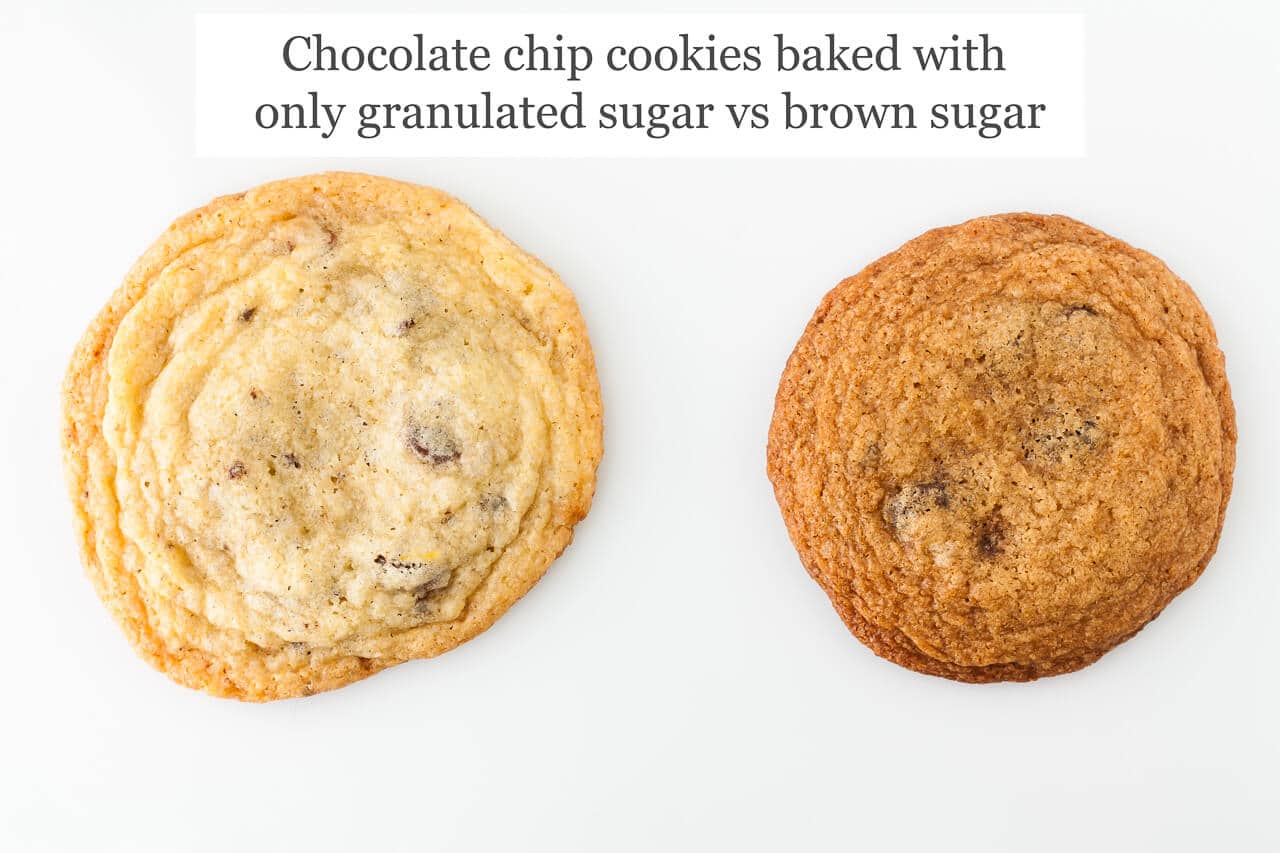
Sugar
Classic chocolate chip cookies call for a combination of white and brown sugar (light or dark). The sugar is essential for preserving the cookies after they are baked, for locking in moisture so that they don't dry out as fast, and also the sugar is key if you are using the creaming method to incorporate some air.
Granulated sugar (regular white sugar or caster sugar) gives a more crispy texture to cookies, while brown sugar gives both flavour and more softness along with some chewiness too. Another thing to note is that sugar promotes cookie spread as they bake, especially granulated sugar: cookies made with 100 % granulated sugar and no brown sugar spread more than the same recipe made with brown sugar exclusively. That's because brown sugar is a little more acidic than plain white sugar, and so that brown sugar will react with the baking soda in most recipes, helping the cookies to rise up rather than spread out. If you like thicker cookies, use more brown sugar than white sugar.
Another thing to note when choosing what type of sugar to bake with: brown sugar lends a ton of flavour to chocolate chip cookies. Chocolate chip cookies made with only granulated sugar tend to have a more eggy flavour, which some might not like. I prefer to bake with a mixture of white and brown sugar, if not with only brown sugar. In fact, lately I've been baking with dark brown sugar to add as much molasses flavour as possible to cookies.
Eggs
The classic recipes for basic chocolate chip cookies will call for whole eggs, usually 1 large egg for every 125 to 190 grams (1 to 1.5 cups) of flour. There are some recipe writers that may recommend to add extra egg yolks to cookie dough to provide more richness, and a more chewy or gooey texture to the baked cookies. More egg whites will contribute to a more crisp texture. Personally, I don't want to separate an egg when I'm making chocolate chip cookies. I can't be bothered.
Too much egg can cause your chocolate chip cookies to taste eggy, especially if there's not enough brown sugar, butter, flour, and vanilla to mask the eggy flavour. Too much egg will also cause the cookies to spread more, so if you want thicker cookies, use less egg (relative to the other ingredients).
Flour
The classic Tollhouse recipe is made with all-purpose flour, the bleached plain flour you find at most grocery stores. On the other hand, the Jacques Torres chocolate chip cookies call for a combination of bread flour and cake flour. The bread flour brings a lot more protein to the cookie dough, which means more gluten and more chewiness in the baked cookie. Cake flour is lower in protein and higher in starch, so it's finer and will give a lighter texture. None will provide much flavour and the role of these flours is mostly structural.
The amount of flour affects the texture and shape
Too much flour will make very thick cookies that hardly spread at all as they bake. The more flour you add, the dryer and harder your cookies will be, especially if you don't compensate with more butter, sugar, and eggs. Conversely, less flour will make cookies spread more as the butter melts and the cookies heat up in the oven. If you want to bake thick chocolate chip cookies, add more flour, but not too much (as compared to the other ingredients in the recipe)!
The type of flour affects the flavour, texture, and shape
All-purpose flour has that name for a reason: it's a pretty easy flour to work with, it's readily available, you can use it to make most recipes, and it's not overly flavourful. Whole wheat all-purpose flour has more flavour than bleached white all-purpose flour, and cookies made with whole wheat spread a little more than with all-purpose, but not so much so that you have to fiddle with the quantities.
On the other hand, rye flour has a ton of flavour (grassy is how some would describe it) and it's lower in gluten and can lead to denser baked goods (rye flour is commonly used in bread making). Bake a chocolate chip cookie with rye flour and it will be thicker and more chewy.
Spelt flour is very fine and soft, with a texture similar to cake flour. For this reason, it leads to a softer cookie with a lighter texture. Oat flour is also very fine and soft, adding a sweeter flavour to cookies. Corn flour behaves much like spelt and oat flour, and it is the sweetest of them all. The flavour of corn flour is very interesting in a chocolate chip cookie. Give it a try! With spelt, oat, and corn flour, you have to add slightly more than you would all-purpose to achieve similar results.
Buckwheat is another flour with a ton of flavour that is very polarizing: some love it, others hate it. Buckwheat is described as nutty, vegetal, and earthy, and it has a very fine texture. To make chocolate chip cookies with only buckwheat flour, you have to use much more than the other flours, especially if you want a thicker cookie.
Chemical leaveners—Baking soda vs baking powder
Baking powder, made up of baking soda plus an acid (or two) is a complete chemical leavener that requires water and heat to react and nothing more. Baking powder added to cookie doughs will open the crumb, leading to a lighter middle but also to crispier edges.
Baking soda added to cookie doughs will still react because the sugars added to cookie doughs provide a little acidity. But still, the baking soda won't all react and its presence actually contributes to the faster browning of the cookie (Maillard browning, specifically). Baking soda helps the edges of the cookie to brown in such a short baking time. Without it, your cookies may end up looking pale, and not as appealing.
Salt
In the cookie dough itself, most recipes will call for either table salt or fine kosher salt. Remember that table salt is twice as salty as fine kosher salt (like Diamond Crystal) so make sure you use the salt the recipe recommends, or adjust the amount according to the type of salt you are using.
Some recipes, those made with salted butter, may not have any other salt added to the dough and the butter provides all the salt. The problem with this is the salt content of salted butters can vary from brand to brand, so it's hard to judge if there will be enough salt in the recipe if you bake with salted butter.
Many will add flaky sea salt, Fleur de sel, or Maldon salt to garnish the balls of cookie dough before baking. The salt will stay intact as the cookies bake, and give a little salty crunch, which helps balance the sweetness.
Vanilla extract
Most recipes call for pure vanilla extract, but you can substitute imitation vanilla for vanilla extract and your cookies will still taste like the real thing. In fact, using imitation vanilla (also known as vanilla essence) in a recipe like this is actually what might lead to a more pronounced, striking vanilla flavour.
Chocolate chip cookies are not a place for precious, expensive vanilla beans. Save those for a vanilla bean pastry cream, vanilla bean panna cotta, or your favourite ice cream. The beans would be wasted in cookies because there's no step that involves extracting the flavour to infuse your dough. Stick with extract or essence, here. If you really want to bake with the beans, I'd suggest using vanilla bean paste, teaspoon for teaspoon, in place of the vanilla extract.
If you are out of vanilla and need a substitute: add some whiskey or bourbon instead of the vanilla!
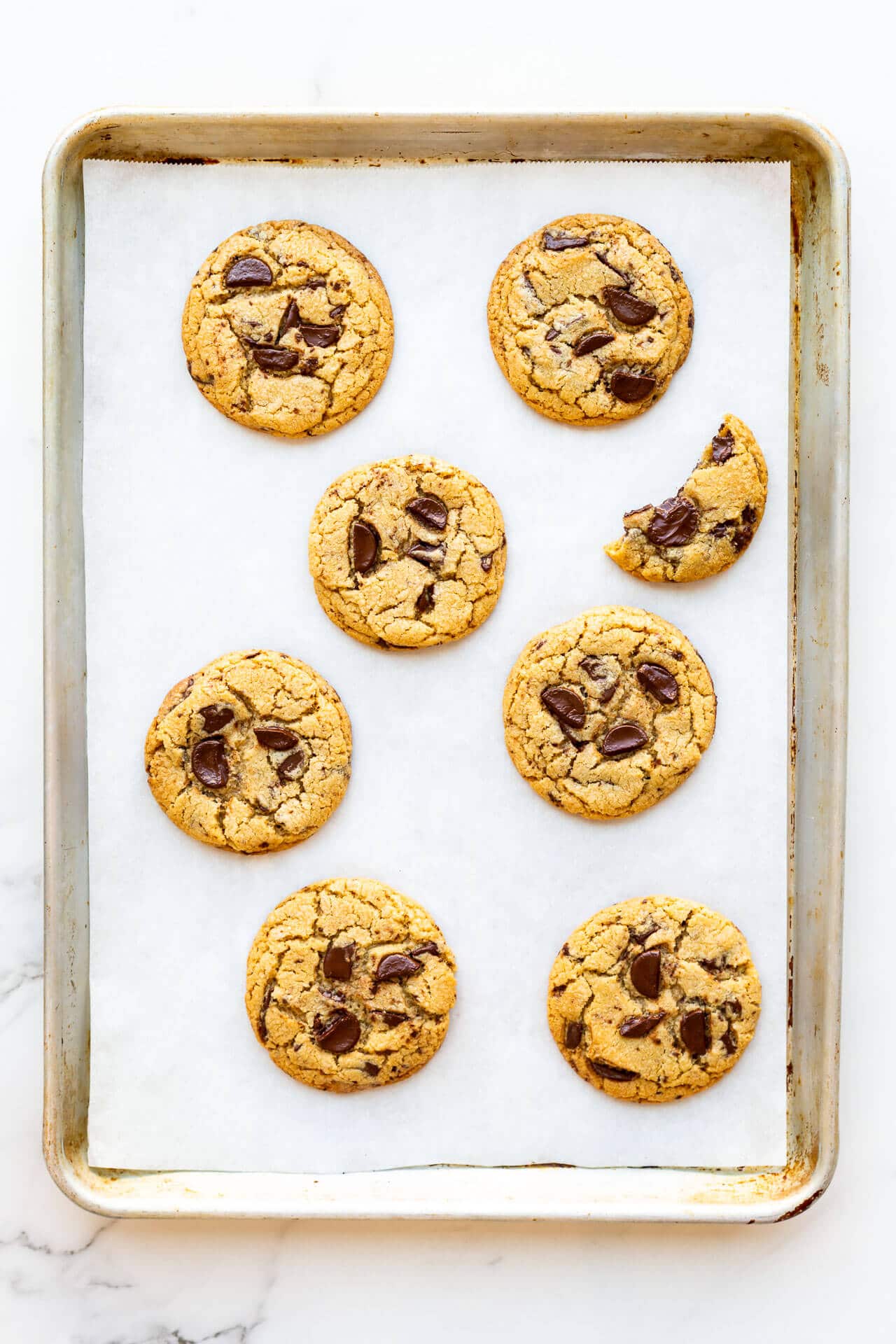
The chocolate: chips versus chunks and what type of chocolate to use
Obviously the Nestlé Tollhouse chocolate chip cookies call for Nestlé Tollhouse chocolate chips, which are a semi-sweet chocolate chip. There's nothing wrong with chocolate chips, but sometimes, especially if you add a lot of chocolate chips to your cookies, you may notice the chocolate chips are too sweet for your cookies. You might actually want to use a different chocolate type for making chocolate chip cookies.
These days, I prefer to bake my chocolate chip cookies with dark chocolate, preferably with a 70–80% cocoa content that is bittersweet, not sweet. A chocolate like Cacao Barry Ocoa, which is a 70 % dark chocolate would be perfect. Cacao Barry's Saint Domingue would also be great here. You could also opt for Lindt Excellence 70 % dark chocolate which is sold in 100 gram bars in most grocery stores these days and also isn't sweet. It's the perfect balance for the sweet-salty cookie dough.
The idea is to provide contrast in flavours and a bittersweet chocolate that is at least 70 % cocoa will provide a good amount of bitterness to balance out all the sugar in your recipe.
If you aren't working with chocolate chips, you will have to chop the chocolate to incorporate it in your cookie dough. How you chop it will have an impact on your cookies. For example, you can use a food processor to make finer shards of chocolate for your cookies, as I did when I adapted the Jacques Torres recipe in these chocolate chip cookies: you can see that the dough is darker because the finer shards of chocolate melted into the cookie dough. I loved that effect and the flavour was great!
Another thing to note when baking with dark chocolate as opposed to chocolate chips: chocolate chips are formulated to keep their shape as they bake, without melting, even in a hot oven. On the other hand, most quality dark chocolate is not formulated for this and will melt as the cookies bake, creating puddles or pools of chocolate on top and throughout the cookie. Make sure to give ample time for the cookies to cool and for the chocolate to set again before packing them, otherwise, they may stick to each other.
To chill or not to chill
Chilling dough is really important for cutout cookies and pie dough. There have been countless blog posts and newspaper articles about how chilling improves flavour and texture, but honestly, most of the time, I can't be bothered.
When I'm making chocolate chip cookies, I want them now, not in 24 to 48 hours, or worse, 72 hours! Still, you can absolutely take cookie dough and chill it overnight (or for longer). You can even freeze scoops of cookie dough and future-you will be ever so grateful!
Gluten-free flours often take longer to hydrate and absorb surrounding oil and humidity. When you don't give them enough time to do so, the cookies will inevitably spread fast as soon as they hit the oven. For this reason, chilling is important, though still not essential. I found with oat flour especially, the flavour was much improved by chilling the balls of cookie dough overnight in the refrigerator before baking. But that being said, it's optional and you can absolutely bake the freshly made cookie dough right away. No stress!
With many of the alternative flours (buckwheat flour, oat flour, corn flour, and spelt flour), you have to add more flour to the cookie dough in order to be able to bake the freshly made cookie dough right away without compromising the thickness and the chewiness of these cookies.
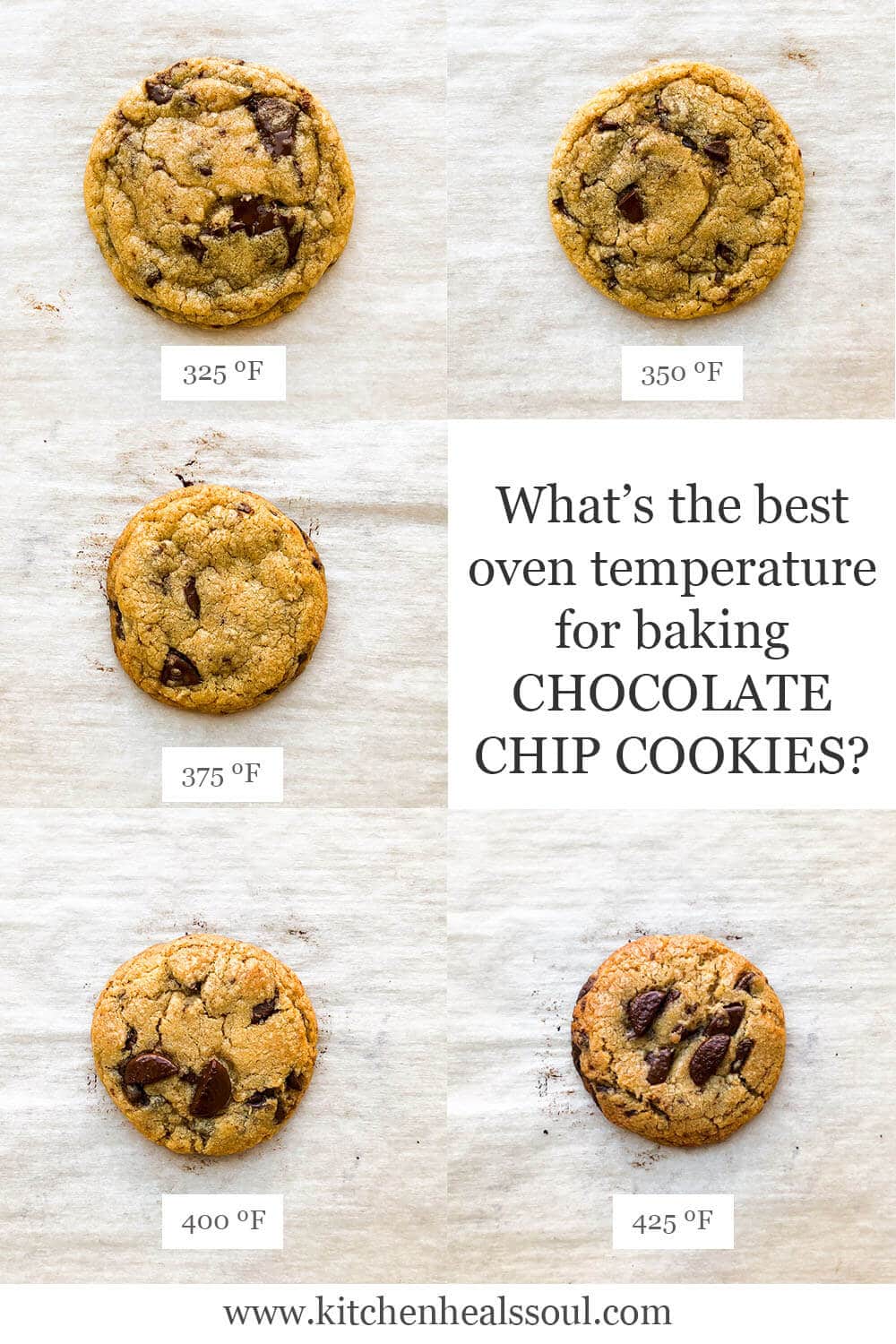
What's the best temperature to bake chocolate chip cookies at?
The temperature you preheat your oven to is entirely dependent on the type of baking sheets you are using, but also the type of chocolate chip cookie you want to make.
I bake with light-coloured, standard restaurant-style sheet pans from Nordic Ware. These half-sheet pans are made with aluminum and because they are lighter in colour, they don't absorb as much heat as darker sheet pans and so browning/burning doesn't happen too quickly. This is a good thing.
If you are using darker sheet pans, you will have to drop your oven temperature by 25 ºF compared to what the recipe recommends. Darker sheet pans absorb more heat and cause cookies to burn on the bottom if you don't adjust the temperature of your oven to compensate.
If you bake your cookies on a sheet pan lined with a silicone baking mat, your cookies will take longer to bake and they will be softer. The silicone mat is insulating, which means the cookies won't brown as much on the bottom. This leads to a softer cookie than on a parchment-lined sheet pan.
Bakeware aside, if you are baking with standard sheet pans, if you want your cookies to spread more and bake thinner, and crisper, bake them at a lower temperature (try 325 ºF or oven 300 ºF) and let them bake for longer. The lower oven temperature allows the butter to melt and the sugar too, which will cause the cookies to spread, and because the oven temperature is lower, the exterior of the cookie takes longer to set, allowing the cookie to spread out more.
If you want a gooey chocolate chip cookie that is soft on the outside, try baking at a lower temperature, like 325 ºF and don't over-bake your cookies. They should still be quite raw in the middle and very delicate when you take them out.
I like thicker cookies that are really "meaty" and to achieve this, besides adding more flour to my recipe, I also like to bake the cookies at a higher temperature, 375 ºF or even 400 ºF. This way the exterior of the cookie heats up faster, setting and creating a crust before the butter has time to melt. The cookies will end up thicker for this reason, held together by the crispy set exterior. This is the way to achieve thick cookies that have a crispy exterior and a gooey interior.
In the case of very thick cookies, the outer crust of the cookie may crack or crackle as the interior melts and expands under the crunchy exterior. For thicker chocolate chip cookies, bake them at 375 or 400 ºF.
Regardless of the temperature you bake them at, remember that your chocolate chip cookies will continue to bake on the sheet pan as they cool. Given this, you can now understand why the time the cookies spend in the oven is so brief!
How to store raw cookie dough
If you decide to chill your cookie dough to let the dough "cure" and for the flavours to develop, I prefer to roll the raw cookie dough out into 50-gram balls. You can place them in a zip-top bag or even in a closed plastic container.
Freezing raw cookie dough and how to bake them later
If you decide to freeze your portioned out cookie dough unbaked, I like to place it in an air-tight zip-top freezer bag, being careful to remove all the air before zipping the bag closed. Then you can store them in the freezer for several months.
When you are ready to bake the frozen cookie dough, simply place them on a parchment-lined cookie sheet to bake from frozen. Let the cookies defrost for 10 minutes at room temperature, while you preheat your oven. The cookies will inevitably take longer to bake, look for the tell-tale signs that they are done: the edges should begin to brown and the surface should look like it's beginning to set, without being baked through.
How to store freshly-baked chocolate chip cookies
Once the baked cookies have cooled completely (emphasis on the completely!), I store my freshly baked chocolate chip cookies in a sealed container. As you store them, in the first few days, you will notice they will dry out just a little and become even chewier. I find they hit peak chewy on day 2. After that, the cookies will really start to dry out more.
Also, there isn't much hope for conserving the gooey freshly-baked texture when you store chocolate chip cookies, unfortunately. If that's the texture you look for in a chocolate chip cookie, you are better off storing the raw cookie dough than the baked cookies. This way you can bake them when the craving strikes.
To keep them moist, you can try the same tricks you would use to keep brown sugar fresh and moist:
- put a marshmallow in the container with the cookies
- put a slice of bread in the container with the cookies
- put a slice of apple in the container with the cookies
- put a hydrated terracotta brown sugar keeper in the container with the cookies
Freezing freshly baked cookies and how to defrost them later
Most people aren't aware that chocolate chip cookies freeze beautifully. You can do so in a zip-top freezer bag, being mindful to suck all the air out of the bag before placing in the freezer. Then when you want a cookie, take one out and gently reheat it in a low oven (250 ºF) for around 10 to 15 minutes to achieve a warm chocolate cookie that's as good as freshly baked. Future you will be very thankful for that stash of frozen baked chocolate chip cookies on those late nights when you have a craving for freshly-baked chocolate chip cookies that you can't ignore! Trust me.
By the way, you can also chop up extra cookies into small pieces and freeze them to churn into a batch of homemade cookie ice cream!
How to change the type of flour used in a chocolate chip cookie recipe
Things can get quite tricky if you want to use a different flour instead of all-purpose in your favourite chocolate chip cookie recipe. All-purpose has roughly 10 % protein, which gives cookies structure, preventing the cookies from spreading too much in the oven. The ratios used in the classic recipes were developed for all-purpose flour. For this reason, you can't just replace all-purpose flour with another and expect the same results. Even worse, if you want to work with gluten-free flours, most of which have significantly lower protein content and no gluten for structure. You will inevitably have to make adjustments to your recipe. Here's how:
The chocolate chip cookie recipe below can be adapted in the following ways with a variety of flours:
- replace the all-purpose flour with:
- whole wheat flour: 190 grams (1.5 cups) whole wheat flour to make whole wheat chocolate chip cookies—note that at 190 grams (1.5 cups) of whole wheat flour, the cookies spread out more than they would with the same weight of all-purpose, but they are still on the thicker side so I don't think you should add more flour than this.
- rye flour: 190 grams (1.5 cups) rye flour to make rye chocolate chip cookies (basically replace with the same amount)—any more rye flour makes the cookies too thick and way too chewy, and less rye flour results in a much thinner cookie that spreads out. Also note that chocolate chip cookies made with 100 % rye flour will be quite chewy, even freshly baked.
- spelt flour: 220 grams–250 grams (1.75 cups to 2 cups) spelt flour to make spelt chocolate chip cookies— at 250 grams of spelt flour, the freshly baked cookies are quite thick, with a crispy light exterior and a gooey interior. Use just slightly less if you prefer you cookies a little more spread out (so 30 grams or ¼ cup less)
- oat flour: 220 grams–250 grams (1.75 cups to 2 cups) oat flour depending on how thick a cookie you want (note you can also replace the chopped chocolate with raisins to make them gluten-free oat flour raisin cookies )
- corn flour: 220 grams–250 grams (1.75 cups to 2 cups) corn flour, depending on how thick a cookie you want
- buckwheat flour: 310 grams (2.5 cups) buckwheat flour to make gluten-free buckwheat chocolate chip cookies—less works, but the cookies spread quite a bit!
- add oats:
- add 95 grams (1 cup) of rolled oats, along with peanuts and swapping milk chocolate for dark chocolate to make these thick chewy oatmeal cookies with milk chocolate and peanuts
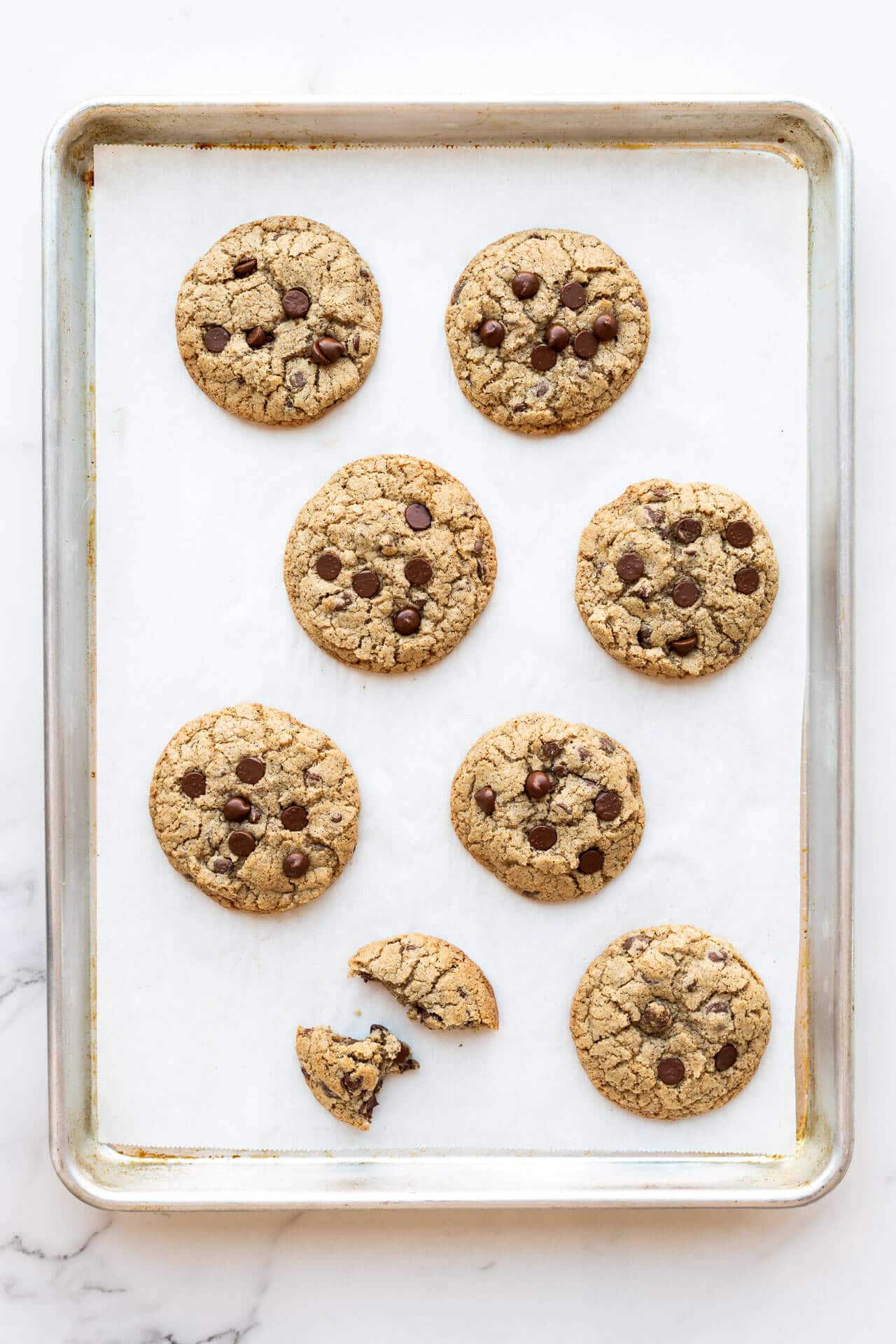
Other ways to change up this recipe:
Feel free to modify this recipe to make your version of the best chocolate cookies. Here are some ways to adapt this recipe:
- Add nuts: when you add in the chocolate, also mix in 110 grams (1 cup) chopped nuts like pecans, walnuts, or even peanuts or pistachios.
- Add seeds: when you add in the chocolate, also mix in 110 grams (1 cup) sunflower seeds or pumpkin seeds.
- Add sprinkles: if you want a funfetti chocolate chip cookie or a "birthday cake" style cookie, mix sprinkles in with the cookie dough. I like adding rainbow jimmies to cookie dough.
- Add peanut butter: when you cream the butter with the sugars, you can add 125 grams (½ cup) of all-natural peanut butter because the recipe below is VERY similar to this recipe for classic peanut butter cookies.
- Change the chocolate: I love to make chocolate chip cookies with chopped dark chocolate that is preferably 70 % cocoa and not too sweet, but you can also use milk chocolate, white chocolate, or a combination of the three. Make sure you stick to the same total quantity of chocolate though. Try adding toffee bits, butterscotch chips, or even peanut butter chips for a completely different flavour.
- Replace the chocolate with chopped dried fruit: you can replace the chocolate with raisins, dried cranberries, dried blueberries, dried sour cherries, chopped crystallized ginger, chopped dates, etc. Substitute cup-for-cup, or do a mixture of chocolate and dried fruit. Up to you!
- Add in something crazy: take inspiration from Christina Tosi's Milk Bar compost cookie recipe and her compost pound cake and throw in some salty potato chips, chopped pretzels, coffee grinds! I've added oats, white chocolate, and blueberries to the same cookie dough base to make these gorgeous blueberry white chocolate cookies
- Garnish: you can't go wrong with a sprinkle of flaky sea salt which will help balance out the sweetness of the cookie dough.
Troubleshooting
If you ever run into the problem that your cookies are burning on the bottom and staying raw in the middle, it could be the material of your sheet pan (dark bakeware absorbs more heat), your oven temperature might be too high, or even too much baking soda in your recipe.
📖 Recipe
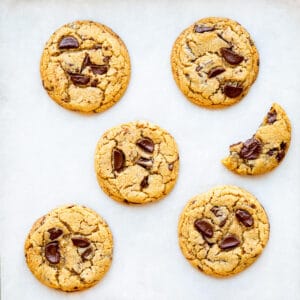
Thick Chewy Chocolate Chip Cookies
Ingredients
- 190 grams bleached all-purpose flour
- 5 mL Diamond Crystal fine kosher salt or 2.5 mL (½ tsp) table salt
- 2.5 mL baking soda
- 115 grams unsalted butter
- 150 grams dark brown sugar
- 100 grams granulated sugar
- 1 large egg(s)
- 10 mL pure vanilla extract
- 175 grams 70 % dark chocolate chopped (approximately 250 mL or 1 cup), or 250 mL (1 cup) dark chocolate chips
Instructions
- Preheat the oven to 400 ºF (200 °C). Line two large sheet pans with parchment paper.
- In a medium bowl, whisk together the flour, salt, and baking soda. Set aside.
- In a large bowl, using an electric hand mixer, cream together the butter, the granulated sugar, and the brown sugar until it's very light and fluffy.
- Add the egg and the vanilla, and mix well until the mixture is light and fluffy again. Make sure to clean down the sides of the bowl as needed with a big spatula.
- Dump in the whisked dry ingredients, and incorporate them either with the hand mixer on low, or by hand with a big wooden spoon.
- Mix in the chocolate. The dough should be quite thick.
- Scoop approximately 50 gram portions of the dough, rolling them into balls.
- Place 7 cookies per cookie sheet, being sure to space them apart and stagger them.
- Bake the cookies one sheet pan at a time until the edges just begin to brown (this takes about 12 to 14 minutes). You might want to rotate the pan partway through the baking to make sure the cookies brown evenly.
- Let the cookies cool completely on the sheet pan while you bake the second pan.
- Store in an airtight container.
Notes
- replace the all-purpose flour with:
- whole wheat flour: 190 grams (1.5 cups) whole wheat flour to make whole wheat chocolate chip cookies—note that at 190 grams (1.5 cups) of whole wheat flour, the cookies spread out more than they would with the same weight of all-purpose, but they are still on the thicker side so I don't think you should add more flour than this.
- rye flour: 190 grams (1.5 cups) rye flour to make rye chocolate chip cookies (basically replace with the same amount)—any more rye flour makes the cookies too thick and way too chewy, and less rye flour results in a much thinner cookie that spreads out. Also note that chocolate chip cookies made with 100 % rye flour will be quite chewy, even freshly baked.
- spelt flour: 220 grams–250 grams (1.75 cups to 2 cups) spelt flour to make spelt chocolate chip cookies— at 250 grams of spelt flour, the freshly baked cookies are quite thick, with a crispy light exterior and a gooey interior. Use just slightly less if you prefer you cookies a little more spread out (so 30 grams or ¼ cup less)
- oat flour: 220 grams–250 grams (1.75 cups to 2 cups) oat flour depending on how thick a cookie you want (note you can also replace the chopped chocolate with raisins to make them gluten-free oat flour raisin cookies )
- corn flour: 220 grams–250 grams (1.75 cups to 2 cups) corn flour, depending on how thick a cookie you want
- buckwheat flour: 310 grams (2.5 cups) buckwheat flour to make gluten-free buckwheat chocolate chip cookies—less works, but the cookies spread quite a bit!
- add oats:
- add 95 grams (1 cup) of rolled oats, along with peanuts and swapping milk chocolate for dark chocolate to make these thick chewy oatmeal cookies with milk chocolate and peanuts
- If you want to add nuts: when you add in the chocolate, also mix in 110 grams (1 cup) chopped nuts like pecans, walnuts, or even peanuts or pistachios.
- If you want to add seeds: when you add in the chocolate, also mix in 110 grams (1 cup) sunflower seeds or pumpkin seeds.
- If you want to add sprinkles: if you want a funfetti chocolate chip cookie or a "birthday cake" style cookie, mix sprinkles in with the cookie dough. I like adding rainbow jimmies to cookie dough.
- If you want to add peanut butter: when you cream the butter with the sugars, you can add 125 grams (½ cup) of all-natural peanut butter because the recipe below is VERY similar to this recipe for classic peanut butter cookies.
- If you want to change the chocolate: I love to make chocolate chip cookies with chopped dark chocolate that is preferably 70 % cocoa and not too sweet, but you can also use milk chocolate, white chocolate, or a combination of the three. Make sure you stick to the same total quantity of chocolate though. Try adding toffee bits, butterscotch chips, or even peanut butter chips for a completely different flavour.
- If you want to replace the chocolate with chopped dried fruit: you can replace the chocolate with raisins, dried cranberries, dried blueberries, dried sour cherries, chopped crystallized ginger, chopped dates, etc. Substitute cup-for-cup, or do a mixture of chocolate and dried fruit. Up to you!
- If you want to add in something crazy: take inspiration from Christina Tosi's Milk Bar compost cookie recipe and her compost pound cake and throw in some salty potato chips, chopped pretzels, coffee grinds!
- If you want to garnish: you can't go wrong with a sprinkle of flaky sea salt which will help balance out the sweetness of the cookie dough.

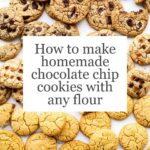
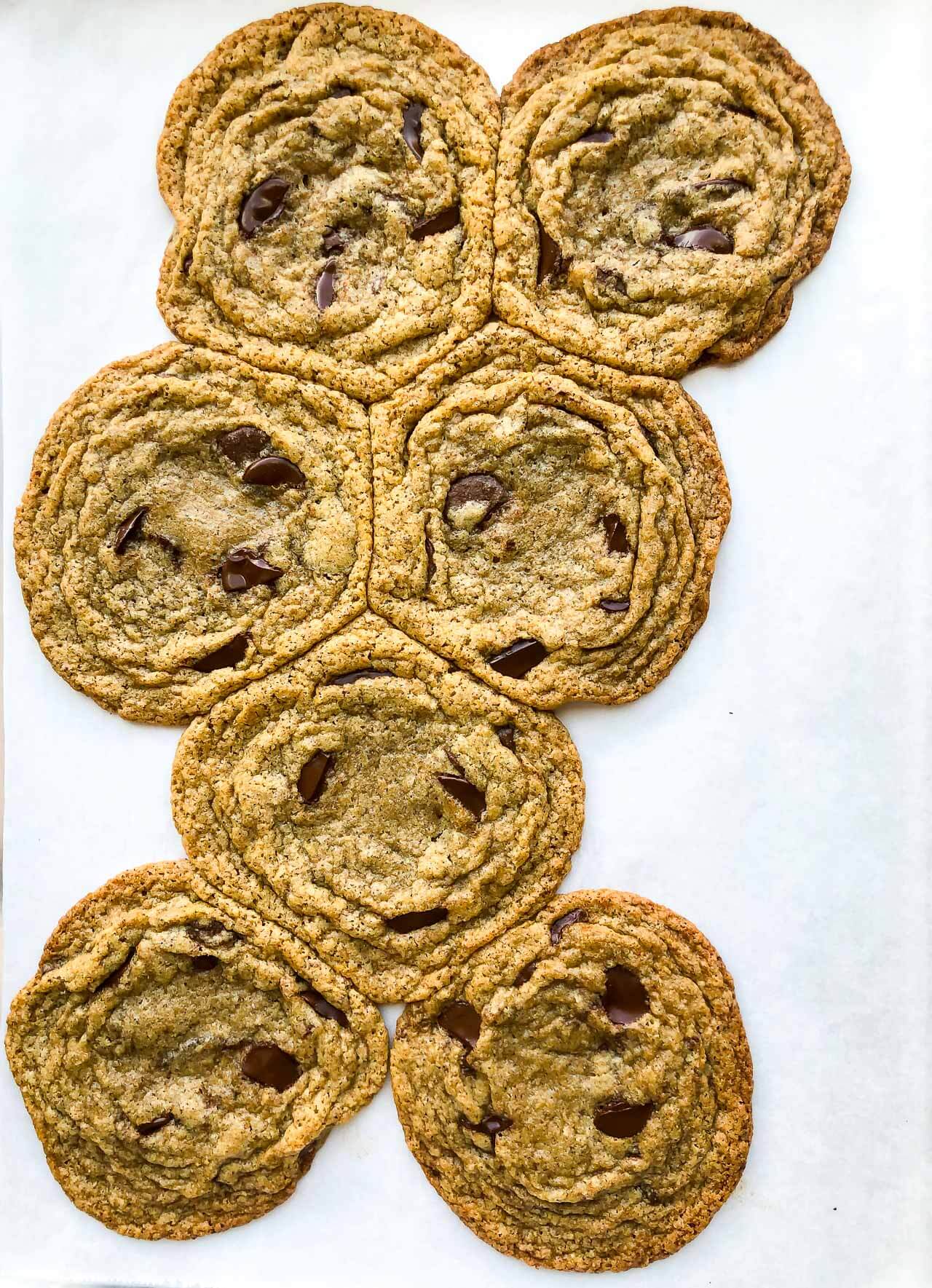
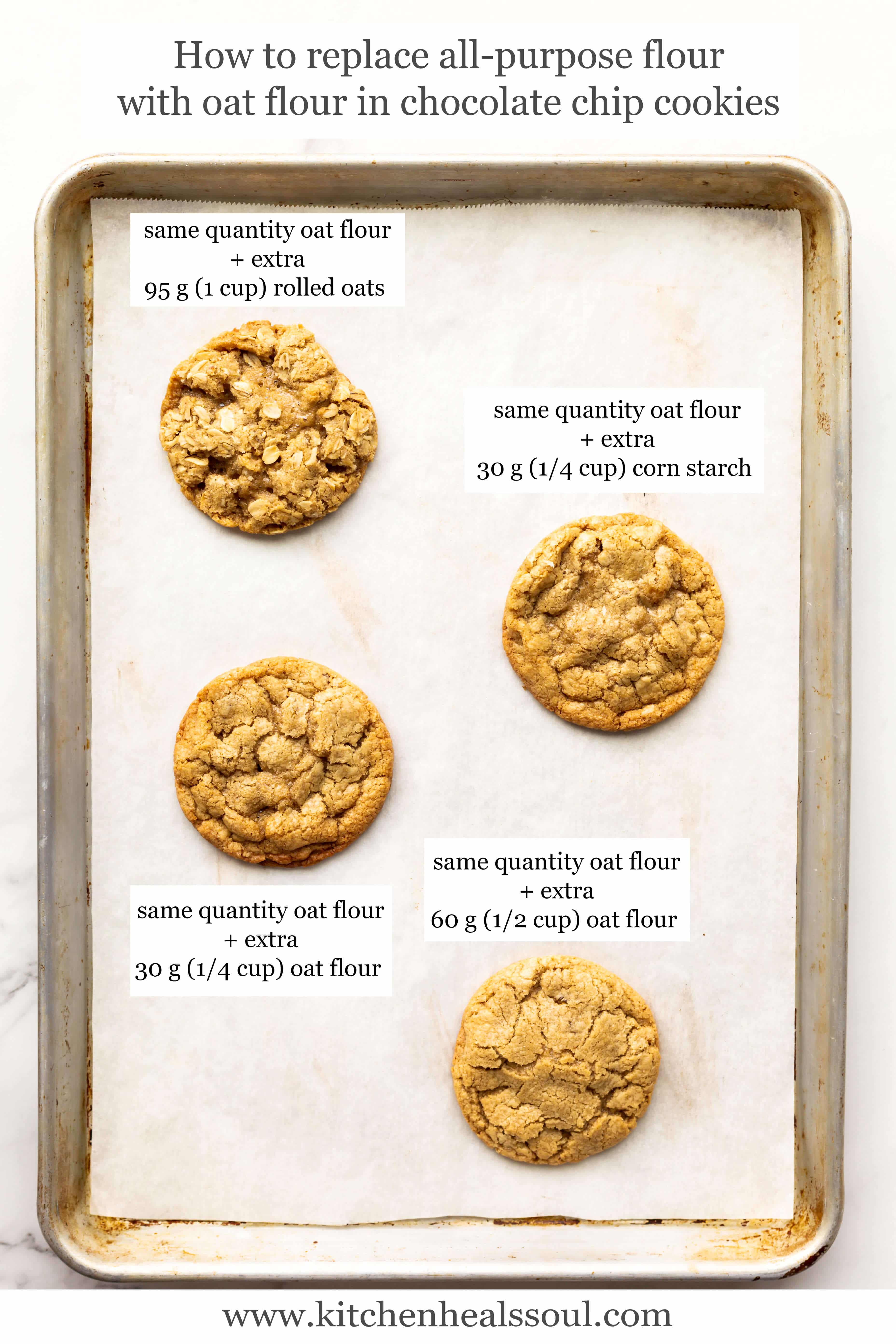
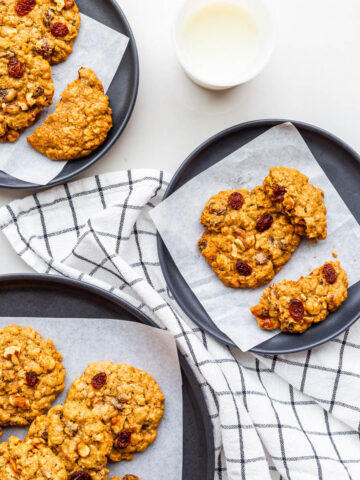
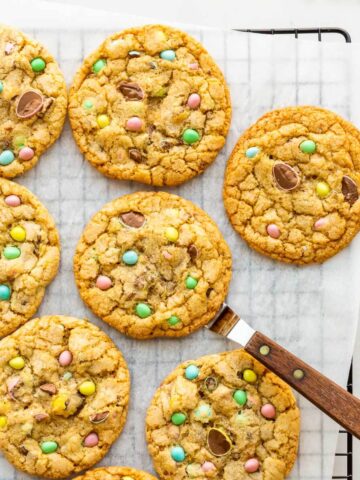
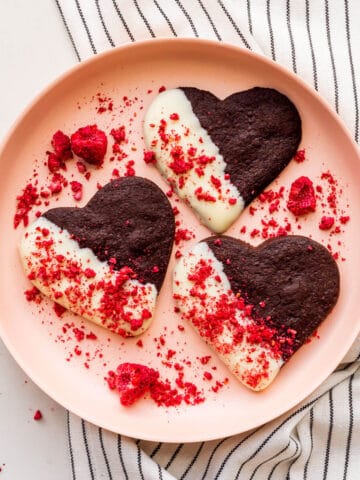
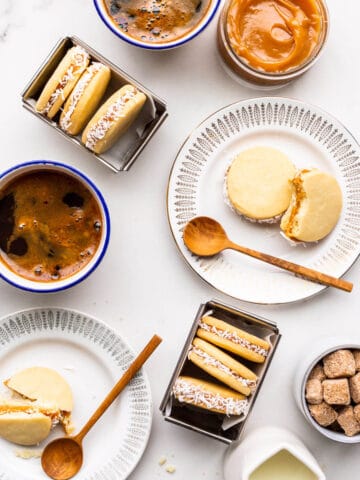
Leave a Reply